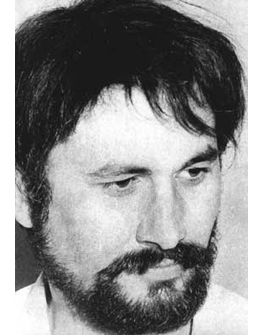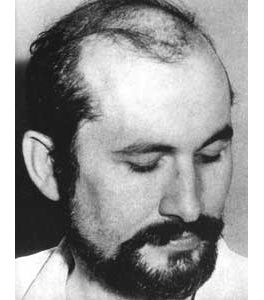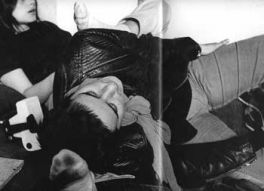The Afterlife of Terrorism in Photography
Astrid Proll’s „Baader Meinhof. Pictures on the Run 1967–1977“
An extensive history of the RAF in Germany, published in 1991, declares defiantly in a one-page preface, „whether we like it or not: the history of the RAF is a part of the history of the Federal Republic.“[1]
I am interested in the assertion that the RAF is part of Germany’s history. What prompts something to be included in a country’s history, and what would cause something else to be neglected, excluded, or forgotten? There has been enormously important and productive work on the procedures by which historiography and politically organized cultural memories (in the form of public holidays, politicians’ statements, textbooks, memorial architecture, etc.) excludes, distorts, highlights, edits, or deletes certain parts of a country’s history. Most familiar, perhaps, are efforts to create a more accurate and comprehensive history of the victims of violence, and of groups who are habitually underrepresented or marginalized in col-
lective accounts. Even when such arguments are conducted in the name of accuracy and comprehensiveness, however, the underlying gesture is to restore a sense of posthumous justice to individuals whose memory is presumably injured by the failure to represent them.
In the 1991 history RAF: Terrorismus in Deutschland, we apparently encounter yet another example of such an effort at inclusion. „[W]hether we like it or not“ strikes a note of defiance and even petulance. „The following pages will not offer a recipe for ways of ending the RAF’s terrorism once and for all. There is no such recipe. Even if certain politicians declare such an end time and again. Always anew after each attack.“[2] The history being offered, then, follows two insights. First, it wants to assert its version of the historical importance of the RAF against the opinions of politicians who would like the problem to simply go away. This impulse still falls within the parameters of restoring justice to those who had been forgotten when, in this case, it is the explicit decision by „certain politicians“ to pretend the RAF no longer exists. But the second reason for writing the RAF’s history is slightly different. The book makes the claim that „the RAF is a part of the history of the Federal Republic“[3] because the author assumes that the RAF has indeed affected the fate of the Federal Republic. The „whether we like it or not“ here implies that the RAF is something that exceeds anyone’s particular opinions because, as an organization, it is potentially greater than ourselves, greater than the Federal Republic, greater than the history of which it is said to be a part. In fact, the implication is that the RAF might possibly attain such historical significance – „after the Revolution“, as one student manifesto puts it that is cited in the book [4] – that the Federal Republic will be part of its history. „There is no recipe to stop it.“[5]
The history of terrorist movements, I presume (and I am no expert in this field), is plagued by this potential for a radical reversal, where the terrorist organization suddenly becomes the conceptual and historical matrix, and the overarching state simply one obstacle and incident in the course of its development. This is so because the kind of terrorism practiced by the RAF targets a state in its forms of symbolic representation, and thus challenges the state as the locus where truth and meaning originate. Much of the RAF’s strategies, and much of the considerable pathos found in accounts of its practices, etc., results from this illusory yet powerful equation of the state with the symbolic source of, and control over all meaning and significance. Hence the defiant and even petulant, somewhat childish tone of the preface to the history of the RAF by Butz Peters, regardless of his actual opinions and judgments on the RAF. As a historian, he is engaged in an analogous campaign of challenging the hegemony of the Federal Republic over its own history. The Federal Republic, Peters suggests, wants to control the telling, or representation of its history by refusing the fact that the RAF plays a part in it. But it is possible, he further suggests, that the RAF will claim its part, and then maybe even all of history through their unstoppable actions. The fantasy at work here is that of a government and state that controls all meaning-production, and has absolute control over how history is told and remembered.
It is not always easy to see that this is a fantasy, but ultimately history is not controlled by one agent. The symbolic order is not identical to the state, or to the father, or to any other actual, empirical entity. The symbolic order is not something one chooses to participate in or opt out of. And yet, the corrective historian’s belief in his power to upend existing stories, while a laudatory impulse, rests on his incorrect equation of the symbolic order with the state as the force that controls absolutely how history is remembered. It corresponds to the adolescent fantasy that the parents hold absolute control over their offspring who must break this control – a fantasy which is encountered in a fair number of the terrorists’ coming-of-age accounts and memoirs. The symbolic order, however, is not controlled by an actual entity. It is not outside of us, but the set of spoken and unspoken convention and rule to which we submit by participating in language and communication at all. When the symbolic order is understood as a totality, this fantasy is countered by the dream of stepping out of the language one has entered (let’s say the language of one’s parents, or the symbols used by a group to define its identity). This dream is dreamt by some historians when they overstate their case and imagine their work to counter, in an actual sense, stories sanctioned by the state. It is also a dream, I would suggest, that fuels the terrorists’ efforts to target not only the state in its actual manifestations and institutions but the symbolic order itself.
So how does the RAF enter into the history of the Federal Republic? Obviously, writing a history of the RAF is a posthumous affair. The RAF was defeated, and will not upend the status of the government or state of the Federal Republic in terms of what is ‚history‘ and what is subordinate to it. And yet the fantasy persists that the state controls history, and that counter-histories must be produced that target the state at this level of the power controlling the symbolic order itself. I turn to Astrid Proll’s 1998 photo book of portraits of victims, perpetrators, and bystanders of the RAF movement while staying mindful of the pervasive fantasy held by terrorists and some historians alike that the symbolic order coincides absolutely with the state. Astrid Proll’s book collates photographs of individuals associated or affected by the RAF. She began her project in 1985 at the behest of a journalist, Stefan Aust. At that time, „there was no interest in a visual presentation of the subject [of the RAF].“ Proll „had very little success [in gathering photos] since the whole subject of the RAF was still traumatic and too personal for most people. Just as the former activists of the defunct West German urban guerilla groups abstained from public statements, so others were reluctant to provide pictures for publication.“[6] The project was shelved for 13 years until 1997, thirty years after the shooting of Benno Ohnesorg in West-Berlin. This second attempt yielded some previously unpublished images, and ultimately resulted in the meticulously edited and artfully assembled book.
The book is produced as a coffee table book, with a striking cover tinted in blood-red that evokes 60’s protest art. The type font is bold face… to evoke the simple means of communication of the leaflet or the manifesto. The book is meant to provoke since it openly aestheticizes terrorism, though not by making anything look pretty. Rather, it relies in lay-out and choice of fonts on the existing codes of „pure communication“ favored by terrorists and media alike. The full-page reproduction of individual portraits also echoes the celebrity-style poster art of various protest movements, cited today in countless reproductions of Che Guevara and the like and now recognizable as the aesthetics of resistance. Proll creates a photo essay comprising four chapters, entitled „Bewegung“ („Motion“), „Action“ („Action“), „Gefangen“ („Imprisoned“) and „Herbst“ („Autumn“) with a series of full-page images that are either full bleed or cropped to leave swaths of certain pages blank. The captions are diminutive, printing vertically, and hard to read. They are merely informative, and the effect of leafing through the book is of looking at newspaper broadsheets or pages torn from newsmagazines from which all explanatory text has been excised. The governing assumption here (Proll works as a picture editor today) is that photographs speak for themselves and that text is subordinated to the power of the image. These pictures are not meant to illustrate an otherwise known or available history. They tell their own, presumably corrective version of history. With this last assumption, Proll seems to align herself quietly with authors such as Peters who strive for a more accurate version of history that would counter reigning discourse.
In a significant way, however, Proll differs in her project from Peters and other revisionist historians. For Proll, these photographs are not meant only to revise a history of the Federal Republic. These images contradict the story of the RAF itself: „many a picture says more than ten commando declarations.“[7] I am not suggesting that other histories of the RAF are explicitly partisan. However, I hope to show that Proll’s book does not challenge the symbolic order from a place beyond or outside of it (and implicitly from beyond the law, the state, or a state-sanctioned history). Her use of these photographs, strangely, remains fully within this order.
The book’s cover does not challenge the power of the state over an individual. The names of Holger Meins, Ulrike Meinhof, Andreas Baader, and Gudrun Ensslin are partially blocked from sight by the book’s title splayed across the detail of a wanted poster. The cover highlights the government’s capacity to print, disseminate, and make public photographic portraits of individuals sought for criminal acts (since post-war German law does not allow for political prisoners). Importantly, not all of these portraits were necessarily taken while an individual was in police custody. Some of them are snapshots ripped from a private life. The power of a wanted poster is two-fold: There is the actual possibility that someone will be identified and arrested because they were spotted, and then there is the state’s symbolic appropriation of a citizen’s image in order to arrest that citizen. The integrity of private existence can be violated and penetrated by the state (and its organs such as the police who will print such images in public) in actuality and in symbolic form. The book cover evokes this power of the state to place an individual’s life within the symbolic order, which rests on the belief that photographs have the power to frame an individual. This power is assumed to be the prerogative of the state. The second assumption made implicitly by Proll is that the photograph harbors revelatory or investigative potential, and that there might be some hidden truth found in photographs that is otherwise unavailable to us.
Now there is something unique about Proll’s book. Peters’s carefully assembled textual history of the RAF is based on interviews with individuals and on police and other documents. Because some of these individuals spoke under assurance of anonymity, Peters’ history appears subversive simply by publishing these accounts. In distinction, Proll aligns her book with the implied assumption that photographs often operate on the side of, as symbolic extension, or as tools of the law. The photographs are reproduced by permission of copyright holders, rather than by permission of the individuals depicted there (many of whom are dead). To print a person’s photograph means to appropriate that person’s likeness for one’s own ends. Yet the photograph might ultimately communicate something beyond the photographed individuals’ intentions, either at that past point in time when the image was taken, or today. More significantly, a photograph might communicate something beyond the editor’s intentions: It might contribute to a story that truly has remained unknown to the photographed individual, the state, and the counter-historian. This is the case in Proll’s book. In Peters’s book (which serves here to illustrate this fundamental difference between textual and visual histories), all parts of the story are assumed to be controlled by their originator’s intentions, who granted them only under the condition of anonymity.[8] All of the evidence is subordinated to these two claims: that of informants who consider their recollections to conflict with other stories, or Peters’s use of these recollections to tell his version of history. There is, presumably, no outside to these testimonies and the information contained therein, or no other dimension that is not either in the service of the state, or works against it.[9]
Instead of casting her project as either defying or supporting a given symbolic order, Proll suggests that her project originates in and remains subordinated to two framing demands issued from within the symbolic order. In an apparently unassuming, deferential, expressly feminine manner, Proll declares that in order to produce this book she first submitted to the wishes and needs of a male journalist and gathered courage only after another male artist had already tried his hand at a similar project. After Stefan Aust’s request for the book, the second impetus for the book was the publication of Gerhard Richter’s well-known cycle of paintings, Zyklus 18. Oktober 1977, which tore these photographs from the codes of the mass media to translate them into the codes of art. „Erst über den Zyklus 18. Oktober 1977 des Malers Gerhard Richter, der diese Fotos aus dem Kontext der Massenmedien riß, konnte ich mich ihnen annähern.“[10] Proll’s book is explicitly flanked by two men dictating or enabling its production.
This is a feint, of course: As Proll recounts in the short introduction following this preface, she was briefly an active member of the RAF and served time in prison, in 1971, for her activities. Richter’s art, presumably, provided the necessary distance to look at these pictures from her own life again. Nonetheless, here Proll positions herself as nothing more than the editor of a few dozen photographs. The introduction ends with the following disclaimer:
Several dozen books document the theory of the RAF, describe their practice or their successful defeat by the state. A book of photographs has been lacking. However, many a picture says more than ten commando declarations. The selection of photographs puts the actors of the first generation of the RAF in the foreground and is, of course, highly subjective.[11]
What allows an image to become part of public memory? How do you insert an image into the existing repertory of available icons? For this to happen, it seems that the symbolic order – which I claim is often erroneously equated with the state or what Walter Benjamin calls the „victors in history“[12], especially in accounts of revolutionary violence, or terrorism – has to be pried open. One plausible option thus appears to place images that run counter to existing narratives into circulation. By thus challenging and exposing as problematic the symbolic order’s underlying assumptions, patterns, or mechanisms, this order is shown to have gaps, inconsistencies, contradictions, or other weak spots. In these spots, then, pictures of a counter-history can be inserted. This method offers an effective and powerful tool to expand existing views of history. In the context of the history and practice of photography, the procedure intends to create, inflate, or exaggerate the symbolic value or impact of certain images. Formerly neglected images are invested with so much affective force that they can no longer be denied a right of inclusion in the canon, the reigning textbooks, the historiographical record, and the archive – all here understood as metonymies of the symbolic order assumed to exist under the name of ,history‘ itself.[13]
In her book, Proll employs a different strategy. She aligns her photographs with, and adopts rather than opposes, the technical means of the reigning symbolic order, which here include certain techniques of and assumptions about framing, captioning, cropping, and editing. The symbolic order, in this project and in distinction to explicitly revisionist histories, is not understood as something closed that can be countered or must be opened up, but as an infinite realm grounded – prior to one’s opinions about a particular institutional framework, story, or context – in one’s participation in shared language. The notion of order is not bound to a belief in actual authority but understood as ,symbolic‘ because it is governed by the collectively shared assumption that language and communication are possible. Proll’s project subscribes to such an understanding of the symbolic order. She does not believe that any one agency holds control over the symbolic, but that the symbolic order is grounded by a shared belief in the possibility of communication, which requires submission to the dictates and rules of society through one’s entry into language.
The symbolic order is not comprised of historians, politicians, and other ,winners‘ of history who conspire to write history itself. It is also not all the records taken together, whether virtual or real. Instead, it is the idea that shared meaning is possible, although there is not one grounding metaphor to anchor the exchange of signifiers. Proll’s project is significant because she uses photographs as adding to rather than prying open the symbolic order or existing accounts of history, and in the belief that meaning cannot be controlled from one position. Such an understanding of how meaning is produced is particularly important when using photographs to tell a story. The photograph, Vilém Flusser maintains, „redirects [the photographer’s] intentions back to the interests of the camera’s program“, which is precisely a program that knows no politics, no morality, no intention.[14] Proll employs photographs in this awareness. But the „camera’s program“ does not mean that no meaning is produced at all. Instead, it means that meaning can occur in excess of the story that can be gleaned from the image, or our knowledge of the framing context supplied by text and other documentation. Photographs cannot be linked to a particular intention with absolute certainty, but stand in conflict with the symbolic order because of their particular promise of immediacy and identity. Photographs appear as actual manifestations, or, in Roland Barthes’s timeless phrase, „emanations of the referent.“.[15] Because of this illusion of immediacy, they express the wish to remain part of the imaginary order that is associated with the fundamental narcissism of considering oneself as identical to oneself, without having to acknowledge the mediation of this knowledge by one’s entry into language and submission to the dictates and rules of shared existence, of society.
Proll’s book does not challenge the symbolic order but neither refuses the desire, caught in each photograph, to have arrested time. This is the narcissistic desire to do without the mediation of others that is necessary for communication to take place; it is the desire not to enter time or memory and not to be subjected to change. Proll’s apparently banal statement on the book’s opening page contains that boundless desire which in her and many other cases prompted participation in the RAF: „One thing is shown on almost every page: We were young back then.“[16] Proll’s book maintains faith in the symbolic order, and at the same time uses images in the full understanding that they challenge or refuse the requirement for shared communication, which is the submission to the rules of language by which we can make known our needs to others. In the case of Astrid Proll’s photo book, several assumptions about photography are upheld. We can say that there are two dominant ways in which photography is related to the social order. First, photography is often considered to share in the state’s efforts of typecasting, controlling, defining, and arresting its citizens in specific roles mapped out on an imaginary grid of compliance with the social order, or conflicting with it. This understanding of photography is rather old, and has been well documented. From the earliest use of photography as an inexpensive medium, the police blotter became a central gathering site for photographs of individuals. We can say that photographic practice immediately aligned itself with the investigative dimension of the law, and can call this dimension of photography its power to frame (as one frames a suspect in a trial). Here the practice of photography, and particularly the camera’s cold, intentionless eye is thought to delimit the individual’s otherwise unruly behavior, and frame his or her potential deviance. In police photography, the assumption is that the portrait at once arrests the individual; the act of photographing someone is in itself already more than an expression but in fact an execution of the law’s reach into an individual’s life.
A series of photographs of Gudrun Ensslin were taken clandestinely while being part of a police line-up (figures 1-4). The assumption is that she is not posing for the camera, but that the resulting photographs capture and arrest for the future an authentic, if momentary dimension of her being that is otherwise lost to the human eye. She is strikingly beautiful, both self-assured and yet somewhat unstudied. The smile on her face, in this sequence of images that show Ensslin like a runway model rather than a criminal, stands in direct contradiction to two dominant stories: the government’s story of a cold-blooded mastermind behind several killings and an accessory to murder, and the RAF’s story of a clear-eyed revolutionary undistracted by the superficial concerns of a corrupt world.
An image of Horst Mahler with and without his wig undercuts existing stories in a similar way (figure 5). The whole point of the identity photograph taken by the police is to confirm one state of being. Yet these two photographs reveal something else. Mahler looks concentrated, focused, and possibly slightly defiant in the first image with his wig. But his closed eyes, slightly more compressed lips, and now unaligned collar in the second photograph suggest something like embarrassment at having been deprived of the wig, which registers in its absence not as an element of disguise but marks intensely private vanity. The embarrassment reveals something thatIwouldnotcall Mahler’s authentic emotion but rather a glimpse of life beneath his political stance and opinions, in this context, the unruliness of lives amidst the network of meanings and intentions available for individuals in the history of the RAF.
These photographs in Proll’s book document something other than what the police intended. This other dimension of unruliness, beneath or above the existing stories of political struggle, is no longer fully explicable in terms of photography’s investigative function, or in terms of photography’s power to frame a suspect. It runs counter to the faith in the symbolic order otherwise maintained by Proll in her book, which is carefully framed as implicitly occasioned by Gerhard Richter and directly commissioned by Stefan Aust. Proll’s book is so forceful because she employs photographs that challenge the symbolic order by dint of the medium, rather than as counter-documents or contradictory evidence. The book’s crucial point is not to show a side of the RAF terrorists that we had not seen before, but to show photography as a medium that participates in the symbolic order and, at the same time, challenges this order with its insistence on the „emanation of the referent.“[17]
On the one hand, the book subscribes fully to the symbolic order, which means that it accepts that communication depends on one’s faith in narrative and symbolization as governed by an unknown, shared principle. But it employs all images also to highlight the photograph’s refusal to be subordinated to any other story, or to recognize another at all.
Helmut Ensslin, Gudrun’s father, stands amidst a horde of news photographers in front of the coffins of his daughter and her comrades after their disputed deaths in a federal German prison (figure 6). The cameras are focused on the coffins, and no one pays attention to the father or to the mother at his side with her head bowed in a gesture of private grief. His upturned chin, clenched mouth, the stark white collar, and carefully held folded coat signal stoic suffering, resolve, and defiance in the face of the loss of his daughter and the vulgar media circus around him. The shot is taken from behind the backs of presumably uniformed policemen keeping order, revealed by the glimpse of a visor of a police hat in the top right corner. But this image from October 27, 1977 does not serve only as evidence of a counter-history to any public representation as a moment of private suffering. There are enough cameras in sight that captured Reverend Ensslin’s mien at this moment. So while the photograph participates in the symbolic order by adding something to our knowledge of this event, it does not step out of this order in terms of content (Ensslin’s role in securing a proper burial for his daughter). Instead, the image shows that at the center of the symbolic order – here metaphorically shown by the cordon of news photographers and police around the coffin and the Reverend – there remains something inexpressible. The father’s role here is not to establish a different authority, and thus implicitly to challenge the existing narratives of this event by securing another story. Such an interpretation of this image would stay on the level of mere content. But the father’s grief and stoic resolve, by dint of the medium, remains eternal. A photograph contains no assurance that there will be an ‚after‘, just as it does not promise to know what came ‚before‘. And this illusion of absolute timelessness in the photograph is employed here not to challenge the symbolic order (the picture was taken by a news service photographer and remains firmly embedded within the orders of communication) but to introduce another order: that of narcissistic self-involvement and the refusal to acknowledge any other which is a mode we enter (or re-enter, if you prefer) in moments of grief.
Proll’s book productively engages the tension between the symbolic order, in which all photographs participate as potential conveyors of information, and the imaginary order, which does not participate in communication but remains enclosed in narcissistic self-consideration without any recognition of the other. All photographs belong to these two orders at once because they do not necessarily yield narrative, or communication, but always hold the promise of absolute timelessness. Roland Barthes asserts that „the photograph possesses an evidential force, and […] its testimony bears not on the object but on time.“[18] The photograph of Reverend Ensslin says first and foremost, even if nothing else can be concluded, that „this happened“. The photograph „mechanically repeats what could never be repeated existentially“, as Barthes writes.19 And this occurrence is not necessarily communicable but remains, like a splinter, within larger narratives of the RAF as a potentially ineffable, incomprehensible experience. The Reverend’s attitude, his grief, his posture: We cannot know what they mean, but not because the symbolic order is so overpowering that it needs to be challenged by historians like Butz Peters. His grief is visible amidst the media and police, and even there it is all too readily turned into a counter-story such as a triumphant story of the state’s victory over its enemies and murderers of innocents, to the symbolic order, here metaphorically represented by news photographers. But something remains on the level of the imaginary order that will not permit the Reverend to be thus instrumentalized since it involves non-communicative, narcissistic self-involvement and self-absorption amidst a crowd, namely the unshareable solitude of grief and loss.
Another image shows the abandonment of youth and displays prominently a dirty sock worn by Ingrid Schubert while lounging with her girlfriend, Astrid Proll (figure 7). Let me make my point explicit by focusing on this dirty sock: It constitutes for me what Roland Barthes calls the punctum that lies outside of the range of intentions of both photographer and photographed subject:
When we define the Photograph as a motionless image this does not mean only that the figures it represents do not move; it means that they do not emerge, do not leave: they are anesthetized and fastened down, like butterflies. Yet once there is a punctum, a blind field is created (is divined) […] the punctum, then, is a kind of subtle beyond – as if the image launched desire beyond what it permits us to see.[20]
The „desire to know beyond what the picture permits us to see“ is to know the story of these two women who were lovers but broke up after Irene Schubert left the RAF, and ultimately Astrid Proll, because she objected to the group’s masculinist cult of weapons. The punctum is the dirty sock that could have made Schubert into someone she did not wish to be: a woman subordinated to the role of maid-servant, attractive lover, or brainy spokeswoman for her armed brothers. Irene’s dirty sock opens another dimension as a blind field within the story of the RAF: its treatment of women in the group. But the sock is a punctum because it launches the desire to see beyond what is shown here, and even beyond this topic of the RAF’s replication of society’s repressive structures within the group. As punctum, the sock does not tell a story but simply engages our impulse to know more. It escapes the intentions of the photographer, the photographed subject, and the photo editor who happens to be one of the people depicted here. Quite literally, in this instance, the dirty bottom of a sock has probably remained invisible to the woman wearing it, and it surely was also not the focus of the photographer who captured it. The sock nonetheless remains part of my experience of viewing this photograph which says, among other things, that these women were alive, that they were comfortable with each other, and that their defiance of conventions (Germans of that period are rarely seen shoeless) occurred already on a level far below that of political, violent action. But the image is defiant in itself, as an image, because it resists the viewers’s expectation that the photographs included in such a book should either demonize or idealize the photographed subjects. In any case, the viewer’s desire to pass a verdict on them is foiled: It is more difficult to pass a verdict on someone with a dirty sock.
The „beyond what the picture permits us to see“ is part of the imaginary order of narcissistic preoccupations, including love, aggression, hate, and grief. In an essay on Roland Barthes’s punctum, Michael Fried has aligned this „beyond“ with the mode of „absorption“ that renders the depicted subject „wholly oblivious to being beheld.“[21] The ‚magic‘ effect of absorption is heightened by two facts: that Proll and Schubert do not simply not care but possibly do not even know about the dirty socks that they are sticking into the viewer’s face (their intentions are possibly exceeded by what the image shows); and that a dirty sock is so trivial in itself and can hardly be staged (the sock says less than what the viewer wants to know about terrorists). The „beyond“ of the picture cannot be readily communicated, and thus does not challenge the symbolic order by writing another version of a story, but by creating within that order a blind field where desire holds sway.
Proll’s achievement, in her unsettling and provocative book, is to employ photographs without reducing or elevating them to the status of counter-evidence, and thus without pretending that they are fully decodable. Her images do not provide a fuller view of the RAF. To be sure, while she condemns the RAF’s violence and blind idealism, she shares in their critique of the German government. But in their failure to offer anything truly new or of historical significance, her pictures suggest that the self-righteous ambition to step out of existing discourse remains an adolescent fantasy. It is a fantasy of breaking with the symbolic order in which we do not participate by subordinating ourselves to anyone, but by using language, and it is a fantasy often found in the manifestos of terrorists who consider the state, the government, or the media, a monolithic, imperial entity that controls all communication.[22]
Proll’s effort is more radical. She introduces, as a punctum and blind field within her book of images, the imaginary within the symbolic, or reminds us of its presence there. She never claims to leave the symbolic order, which she directly invokes by citing the male artist and journalist who prompted her work. While this project does not promise safe political answers, it relies on photographs to avoid the adolescent stance of stepping out of communication altogether (which RAF terrorists did not do), as if communication were something that could be controlled by one agent alone, and the stance that equates the symbolic order with an actual entity in the world. This stance, strangely, seems to have seduced historians and terrorists alike.
[1] Peters (1991), 225.
[2] Peters (1991), 9.
[3] Peters (1991), 9.
[4] Peters (1991), 225.
[5] Peters (1991), 9.
[6] Proll (1998), 140.
[7] Proll (1998), 13.
[8] Peters (1991), 452.
[9] Ultimately, Peters maintains that the state was not affected by terrorism: „Der RAF-Terrorismus hat […] viel […] verursacht. Eines jedoch nicht: Den Staat in seinen Grundfesten erschüttert.“ Peters (1991), 442.
[10] Proll (1998), 7.
[11] Proll (1998), 13.
[12] Benjamin (1968), 255.
[13] Fatimah Tobing Rony analyses and deve-lops the political potential of such strategies in Rony (1996).
[14] Flusser (2000), 47.
[15] Barthes (1981), 80.
[16] Proll (1998), 7.
[17] Barthes (1981), 80.
[18] Barthes (1981), 88f.
[19]Barthes (1981), 4.
[20]Barthes (1981), 57-59.
[21] Fried (2005), 544.
[22] Slavoj Žižek explains this fantasy of the symbolic order in the context of a discussion of the terror attacks of 9/11 in New York City, see Žižek (2002).
Bibliographie
Barthes, Roland (1981): Camera Lucida: Reflections on Photography. Trans.: Richard Howard. New York: Farrar, Straus and Giroux. Benjamin, Walter (1968): Illuminations. Trans.: Harry Zohn. New York: Schocken. Flusser, Vilém (2000): Towards a Philosophy of Photography. Trans.: Anthony Mathews. London: Reaktion. Fried, Michael (2005): „Roland Barthes’ Punctum“. In: Critical Inquiry 31.3, 539-574. Peters, Butz (1991): RAF: Terrorismus in Deutschland. Stuttgart: Deutsche Verlags-Anstalt. Proll, Astrid (1998): Baader-Meinhof. Pictures on the Run. 1967-1977. New York: Scalo. Rony, Fatimah Tobing (1996): The Third Eye: Race, Cinema and Ethnographic Spectacle. Durham: Duke UP. Žižek , Slavoj (2002): Welcome to the Desert of the Real: Five Essays on September 11 and Related Dates. New York: Verso.
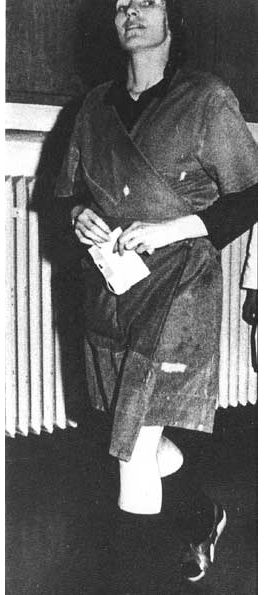
Figures 1-4: Gudrun Ensslin during an identification parade, probably in the Essen prison, 1972. In: Proll (1998), 100f.
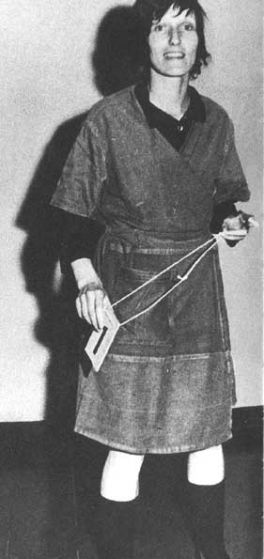
Figures 1-4: Gudrun Ensslin during an identification parade, probably in the Essen prison, 1972. In: Proll (1998), 100f.
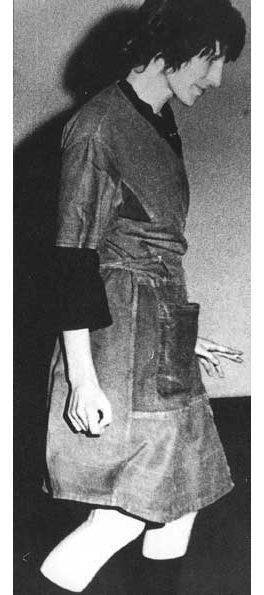
Figures 1-4: Gudrun Ensslin during an identification parade, probably in the Essen prison, 1972. In: Proll (1998), 100f.

